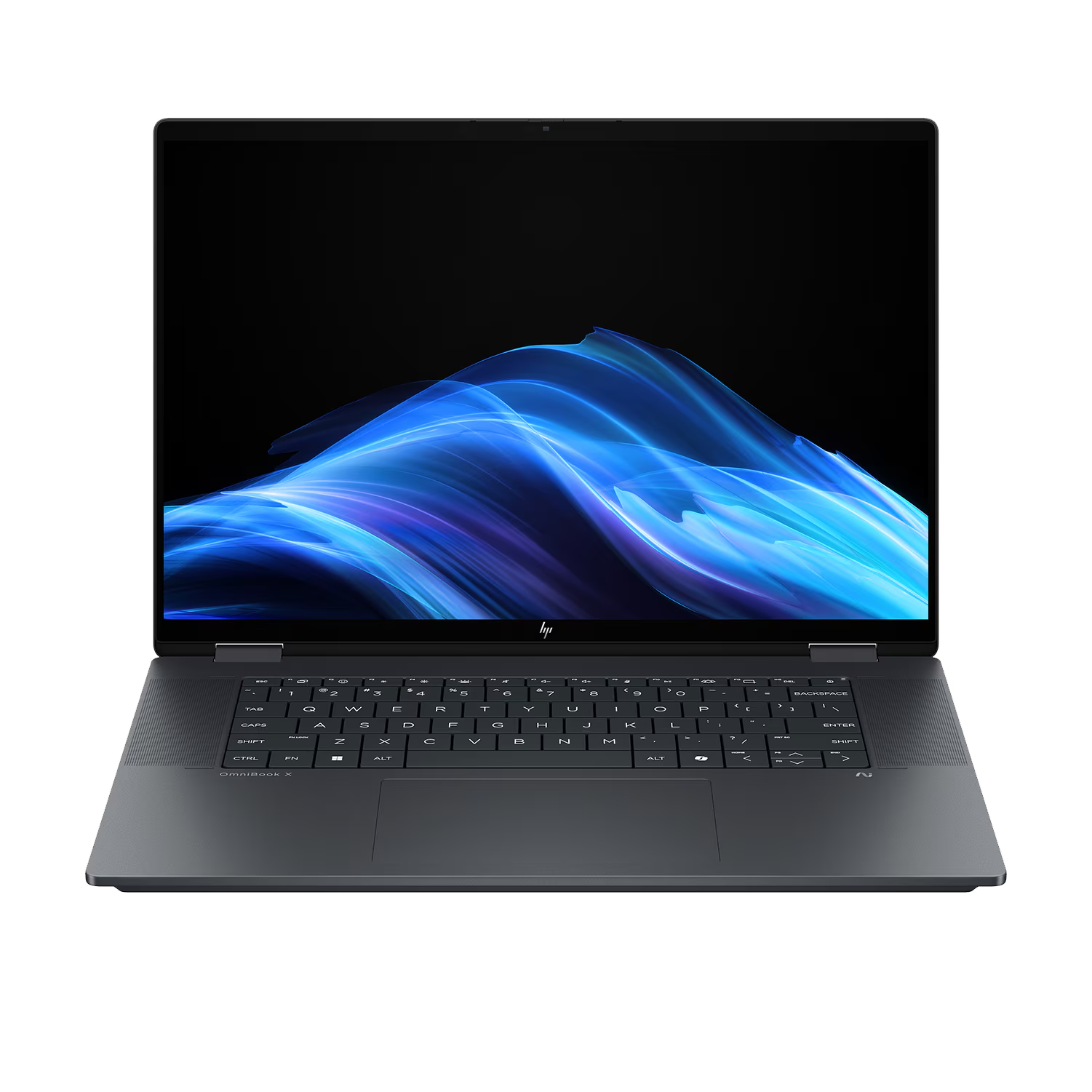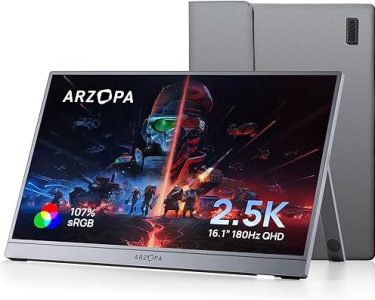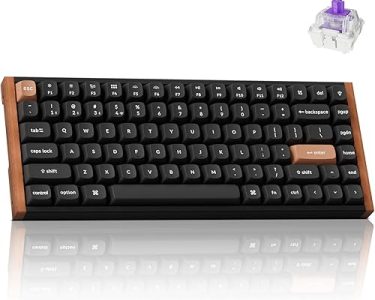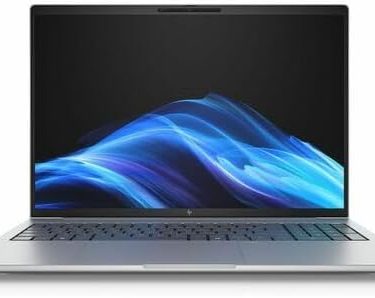HP’s OmniBook X Flip 16 builds on the brand’s 2024 re-launch of the OmniBook series, which debuted alongside the new wave of Windows Copilot+ AI PCs. It launches alongside a 14-inch variant, with both models available in configurations powered by either Intel or AMD chips.
Positioned just below the flagship OmniBook Ultra, the X Flip 16 still offers a premium experience with its sleek metal chassis, modern processors, ample RAM for daily tasks, and a versatile 2-in-1 design. On paper, it checks all the right boxes—but in practice, it falls slightly short of expectations, especially when compared to standout competitors like the Samsung Galaxy Book5 Pro 360.
Specs and features
- CPU: 258V Intel Core Ultra 7
- 32GB LPDDR5X memory; Intel Arc 140V graphics/GPU
- Display: 16-inch Glossy OLED Touchscreen, 2880 x 1800
- 1TB PCIe Gen4 SSD for storage
- 5MP webcam
- Connectivity: 2x USB-A 10Gbps, 1x HDMI, 1x USB-C 10Gbps with Power Delivery and DisplayPort 1.4, and 1x Thunderbolt 4 with Power Delivery and DisplayPort 2.1 2.1, one 3.5mm audio combination
- Networking: Bluetooth 5.4, WiFi 7.
- Biometrics: face recognition in Windows Hello
- Capacity of battery: 68 watt-hours
- 14.02 x 9.67 x 0.61 inches in size
- 4.17 pounds in weight
- As-tested MSRP: $1,659 ($1,099 base)
The HP OmniBook X Flip 16 is available in a range of configurations, featuring both AMD and Intel processors. The base AMD model starts at $899 and includes a Ryzen AI 5 340 processor, 16GB of RAM, 512GB of storage, and a 1920×1200 IPS display. Users can upgrade to a Ryzen AI 7 350 CPU, 24GB or 32GB of RAM, up to 2TB of storage, and a sharper 2880×1800 OLED display—like the one featured in our test unit.
We reviewed an Intel-based model, which, while similar in design, has internal differences that may affect overall performance and battery life. Intel versions start at $1,099, featuring a Core Ultra 5 226V CPU, 16GB of RAM, 512GB of storage, and the same 1920×1200 IPS panel. Higher-tier options include either a Core Ultra 7 256V with 16GB of RAM or a 258V with 32GB. Our test system came fully loaded, with the top-tier CPU and RAM configuration, 1TB of storage, and the upgraded OLED screen, bringing its MSRP to $1,659.
Design and build quality
HP isn’t aiming to win any style awards with the OmniBook X Flip 16. While previous OmniBooks brought some personality—like colorful keyboards—this model sticks to a more muted aesthetic. It features a clean, solid build, but the overall design feels rather uninspired.
This is a large laptop, though not quite in the realm of bulky gaming machines. Its size is necessary to accommodate the 16-inch touchscreen and 360-degree hinge that enables tablet mode. Weighing in at 4.17 pounds, it’s not especially light, but its slim profile helps maintain a sleek appearance. Rounded edges and corners give the design a softer look, and the sandblasted, anodized aluminum chassis feels pleasantly smooth, suggesting HP put some thought into overall user comfort.
One particularly unusual design choice lies on the underside. Instead of traditional rubber feet, the OmniBook X Flip 16 uses thin, barely noticeable strips that sit flush against its gently curved base. These create a subtle airflow channel along the sides, directing air toward the intake fan. Despite the large grille covering much of the bottom panel, only two small sections near the fan function as air inlets.
Heat is expelled through a vent along the rear edge of the base, just below the display. While there are speaker grilles on the top deck, they don’t appear to be used for airflow, nor do they house the actual speakers. Instead, HP has placed two speakers in narrow slots along the front edge of the laptop. This isn’t ideal for traditional laptop use, but it helps maintain consistent audio output in tent or tablet modes.
Connectivity
The HP OmniBook X Flip 16 offers decent connectivity, but like many of its peers, it does not fully utilize its small size. A USB-A port, two USB-C ports, and an HDMI 2.1 port are located on the left side. Despite having a ton of room, the right side only has a USB-A port and a 3.5mm audio connection. It’s good that both USB-A connectors have 10Gbps speeds. However, Thunderbolt 4 is only applied to one USB-C port. Thankfully, both USB-C connections allow DisplayPort output and charging, while the other is just another 10Gbps port.
You can connect wirelessly using Bluetooth 5.4 and Wi-Fi 7 with an Intel wireless adapter. Both have shown themselves to be reliable and fast to connect during my tests.
Performance
Although the HP OmniBook X Flip 16 isn’t designed to be a performance beast, it does have some powerful components. However, at $1,659, it is priced similarly to many other machines that have robust components, and the 2-in-1’s higher price detracts from its attractive appearance.
For a significantly lower price of $1,149, the Acer Swift Go 16 offers a more potent processor coupled with an equivalent quantity of RAM and storage, but it is not a 2-in-1. At $1,199, the Lenovo Yoga 7i 2-in-1 16ILL10 is significantly less expensive despite having a somewhat worse processor and half as much RAM. Samsung, on the other hand, sells both a conventional and a 2-in-1 Galaxy Book5 Pro. The standard model, which costs $1,649, includes only 16GB of RAM and the same subpar processor as the Lenovo machine. The OmniBook X Flip 16 has the same CPU, as well as the same amount of RAM and memory, as the 2-in-1 model that we examined.
The Galaxy Book5 Pro 360 we tested isn’t one that Samsung sells, which makes things a bit complicated. Instead, it’s a $1,699 model (it’s now $1,449) that has the same internals as the regular Galaxy Book5 Pro. Except for Lenovo’s, nearly all of these systems also feature an OLED display that measures 2880 x 1800 pixels.
The OmniBook X Flip 16 is near the top of this group in terms of price, but it performs poorly in the PCMark 10 comprehensive performance test. This evaluates a variety of tasks, such as browsing, launching applications, modifying spreadsheets, adjusting images and videos, and making video calls. Every system works flawlessly and can easily keep up with these kinds of routine activities, but HP simply falls short. A system may occasionally be held back by a marginally slower SSD when compared to rivals with comparable specs; however, the OmniBook X Flip 16 performed poorly in most subtests.
Cinebench enables us to identify one of the factors contributing to the OmniBook X Flip 16’s poorer PCMark performance. Cinebench pushes were primarily CPU-focused. It should come as no surprise that the Acer Swift Go 16’s more powerful CPU gives it a significant advantage in these tests. Nonetheless, the OmniBook X Flip 16’s single-core performance was generally worse than that of its rivals on Cinebench R15, R20, R23, and R24. It outperformed the Lenovo system with its inferior CPU in terms of multi-core performance, but it continuously lagged behind the two Samsung computers, even though one of them shared the Lenovo’s CPU weakness. Even in Cinebench R24, which extends the test to demonstrate the effects of thermal throttling more, it stayed constant.
Battery life
Although it may have been larger, the HP OmniBook X Flip 16 makes use of its compact design to fit a large battery with a 68-watt-hour pack. It can use that battery quite effectively. The OmniBook X Flip 16 operated for over eighteen hours in our 4K local video playback test, which puts the laptop in airplane mode with the screen at 250–260 nits. That’s pretty amazing for a large, angular display.
Even though the battery lasts a long time, it’s not amazing. Compared to some, such as the Acer Swift Go 16 2025, it is significantly superior. Lenovo’s rival model, however, went even farther, and both versions lagged much behind Samsung’s Galaxy Book5 Pro variants. The battery life of both Samsung laptops exceeded 23 hours, even though their technology was quite identical to that of the OmniBook X Flip 16. Those are important leads that cannot be attributed to merely slightly larger batteries. Even more astonishing is the fact that both Samsung systems accomplished this while surpassing the OmniBook X Flip 16 in almost all performance tests.
Conclusion
In nearly equal parts, the HP OmniBook X Flip 16 is a hit and a miss. On the one hand, it looks good, although simple, and feels well-made. It also features a large, beautiful show. However, it also makes perplexing decisions, such as having enormous grilles that hardly do anything. Form takes precedence over function on its keyboard. Furthermore, most users are unlikely to find a 16-inch tablet weighing more than four pounds useful, particularly in the absence of dependable palm rejection.
The performance comes next. It just doesn’t utilize hardware to its maximum potential, frequently outperforming lower-end gear. If HP had made use of all its grilles to increase ventilation and heat dissipation, it might have performed better. However, it didn’t. Despite this, the OmniBook X Flip 16 is somewhat pricey. I don’t see many reasons to pick the OmniBook X Flip 16 over the Samsung Galaxy Book5 Pro 360, except for the fact that it doesn’t come in the configuration we tested. I would anticipate Samsung to perform on par with its non-flipping brother, which, as we showed in our benchmarks, likewise much outperformed the OmniBook X Flip 16, despite having less memory and a lower-tier processor.





